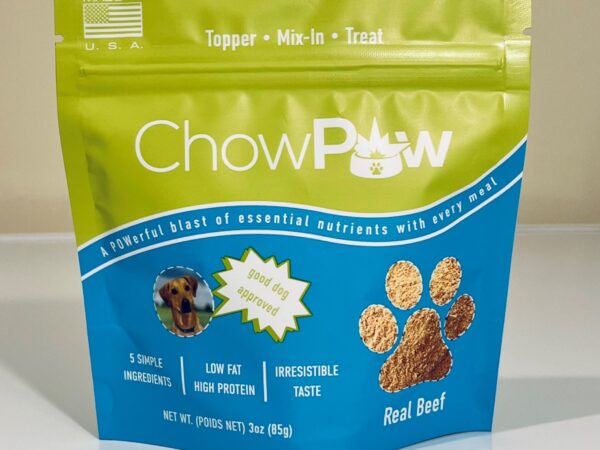
The Power of Slow Feeding: A Guide to Methods, Benefits, and Enhancing the Experience with ChowPow
Updated: March 2024
In today’s fast-paced world, slowing down might seem counterintuitive. But for our dogs, intentional, mindful feeding practices like slow feeding offer profound benefits for their physical and emotional well-being. In this comprehensive guide, we’ll explore what slow feeding is, the various methods available, the pros and cons, and how ChowPow’s Dog Food Topper complements the experience.
Understanding Slow Feeding: More Than Just a Trend
Slow feeding disrupts the habit of rapid food consumption in dogs, a practice that can lead to digestive issues, weight problems, and even life-threatening bloat. Here’s why slow feeding matters:
- Portion Control: Encourages a sense of fullness, helping manage weight and prevent overeating.
- Improved Digestion: Allows food to break down more easily, promoting better nutrient absorption and reducing the risk of vomiting or discomfort.
- Mental Engagement: Transforms mealtime into a stimulating puzzle, combating boredom, and anxiety.
- Behavioral Benefits: Can curb food aggression and promote calmness in dogs who tend to guard their food or eat anxiously.
Methods of Slow Feeding
Let’s dive into the diverse ways to put slow feeding into practice:
- Slow Feeder Bowls: These bowls feature raised patterns that force your dog to work their way around the food, naturally slowing their eating pace.
- Pros: Simple to use, various difficulty levels available.
- Cons: Can be frustrating for some dogs, requires thorough cleaning.
- Interactive Feeders: Puzzle-like devices that release food as your dog interacts.
- Pros: Mentally stimulating, combine food with playtime.
- Cons: May be noisy, some disassembly for cleaning.
- Snuffle Mats: Fabric mats with hiding spots for food, encouraging foraging instincts.
- Pros: Appeals to natural sniffing behaviors, easy cleanup.
- Cons: Best for dry kibble or treats, not as effective with wet food.
- Food-Dispensing Toys: Kongs and similar toys filled with food require licking, chewing, and pushing to release the contents.
- Pros: Durable, provide long-lasting engagement.
- Cons: Can be messy, filling them takes some prep time.
Important Note: Supervision is recommended, especially when first introducing new slow-feeding methods.
Factors to Consider Before Choosing
- Dog’s Size and Breed: Small dogs like Chihuahuas or Yorkshire Terriers, or brachycephalic (flat-faced) breeds like French Bulldogs and Pugs, may need different designs than large dogs like Labrador Retrievers or German Shepherds.
- Eating Habits: Observe if your dog is a gulper or a grazer. Gulpers might benefit more initially.
- Individual Personality: Timid dogs may do better with simpler methods, while energetic dogs might enjoy complex puzzles.
ChowPow: The Perfect Slow-Feeding Companion
ChowPow’s Dog Food Topper enhances the slow-feeding experience in several ways:
- Flavor and Texture: The savory flavor motivates dogs to work for their food, while the texture adds an extra dimension.
- Versatility: Works seamlessly with bowls, puzzles, mats, and toys. Simply sprinkle over kibble or mix into wet food fillings.
- Nutritional Boost: Adds protein, vitamins and minerals, and turning mealtime into an even more nourishing experience.
Conclusion
Slow feeding is a gift you give your dog – promoting health, happiness, and a deeper connection during mealtime. By understanding the benefits, experimenting with methods, and incorporating ChowPow, you elevate their dining experience and set the stage for a long, healthy life.






